Picking out seeds is no easy task! I'm sharing my picks in hopes to help you decide what you might like to buy.

Repeats from 2023
I recently moved from the Bay Area to the Midwest - which has required me to experiment with new varieties better suited for the hot & humid summers. Over the past 3 years I've found a few new favorites that I will be growing again in 2024.
- Lettuce: Super Jericho - a super crunchy romaine - the best I've found after testing several varieties
- Celery: Tango - a common variety which is more flavorful and less stringy than grocery store options
- Carrot: Danvers - a reliable standard sized, orange carrot
- Snap Pea: Spring Blush - a pink & green pod easy to spot on the vine
- Pepper: Jimmy Nardello - full flavored, not spicy, very multi purpose
- Summer squash: Green Tiger - a stunning striped variety
- Slicing tomato: Green Zebra - excellent flavor!
- Cherry tomato: Principe Borghese - the best variety for sun drying
- Paste tomato: Amish Paste - larger than any other paste variety I've grown
- Winter squash: Honeynut - a single serving butternut that turns from dark green to orange when ready to harvest
Below is my full list of vegetable seed choices, in alphabetical order.
Jump to:
Beans
My picks:
- Bush beans: Mix beans from MIgardener which includes Topcrop Yellow, Royal Burgundy, and Blue Lake
- Pole bean: Greasy grits: a nutty
- Soybean: Chiba soybean
I haven't spent enough time evaluating beans to have picked a favorite, or even enough notes to offer advice. That's why I went with the "Mixed beans" option to get a little of everything to see what works well.

Carrots
My pick: Danvers
I planted Danvers carrot seeds last year and they did surprisingly well. Surprising because I never had luck growing them in the Bay Area, but they loved my raised beds in the midwest. They grew easily into full sized, straight carrots, even in a crowded bed.
The carrots were flavorful and sweet. The first one I picked was a bit earthy, but every one after that was excellent, especially the ones I harvested after a couple of light frosts.

Celery
My picks:
- Pink plume - version with pink stalks and green leaves
- Tango
Until last year, I had never planted celery in my garden. It seemed like such a boring option among so many other vegetable choices. But I finally decided to plant a couple, for science.
I bought a couple of Tango green celery plants and put them in the garden. I was unexpectedly delighted with the outcome. They were maintenance free and lasted well into the cold weather without additional protection.
The stalks were crispier and less stringy. They had a very strong celery flavor - a stark contrast to the bland grocery store version. As someone who will eat raw celery but not particularly care for it one way or the other... I can definitely say I look forward to eating this from my 2024 garden.
I'm trying a popular green variety as well as Pink Plume for the fun of it. Pink celery would look great on a veggie try, stuffed as an appetizer, or chopped into a chicken salad.

Corn
My picks:
- Golden Jubilee - a sweet corn
- Chires baby - a baby corn
Corn is tricky - you really need to pick one variety, and only one variety. That's because when they cross pollinate, the kernels on each cob are no longer true to the original variety you were trying to grow.
Last year I planted Golden Bantam. It's an old variety with that old timey corn flavor but significantly less sweet than modern varieties. It's nearly impossible to find this type of corn anymore, even at a farmers market. I really enjoyed the flavor but had a very difficult time harvesting it during the small optimal window.
If corn is picked too early, the cobs aren't fully filled out. If it's picked too late, it is starchy. It's hard to describe what that tastes like, but it's really quite terrible and almost inedible. Golden Bantam has a window that's only several days long and I missed the window a bunch!
Modern varieties, like Golden Jubilee, have a longer harvest window. That window is usually up to two weeks long. I hope to have good luck harvesting this variety. In addition, I am trying Chires Baby corn which produces a heavy crop of baby corn on each stalk. I will be separating this from my other corn by moving it around the corner and 70 feet away.
Cucumbers
My picks:
- Boston Pickling
- Wisconsin SMR Pickling
- Muncher
I'm not sure why, but I have a mental block when it comes to growing cucumbers lately. I forget about them until they get so big that aren't very tasty. I fully intended to try making pickles last year but didn't harvest the Early Fortune cucumbers early enough.
This year I am trialing pickling cucumber varieties. These types of cucumbers stand out for their thinner skin and firmer flesh that holds up well through the pickling process.
Boston Pickling is a classic choice, but I also wanted to try the one developed at the University of Wisconsin. Lastly, Muncher is a burpless variety that works well for salads and pickling.

Lettuce
My pick: Super Jericho, a heat tolerant, sweet, crispy romaine.
I'm always searching for a super crispy romaine lettuce, which seems harder that it should be. I've tried Crisp Mint, Paris Island Cos Romaine, and Green Ice. Most end up flimsy, bitter, or they bolt at the first sign of heat. But I finally found a winner: Super Jericho.
I planted this last year along with other varieties. This was far superior, holding up during a 6 week drought in the hot Midwest summer last year.
Parsnips
My pick: All American Parsnip
I've never grown parsnips. But after last year's success with carrots, I'm excited to see how the parships turn out.
I grew carrots in a couple of my raised beds, with great root formation. They tasted fresh, sweet, and flavorful... a noticeable improvement from the bland, slightly earthy, woody grocery store variety.
Parsnips from the grocery store are often woody and more earthy than I feel they should be. Here's to hoping they meet my expectations in the garden this year.
Peas
My picks:
- Spring blush snap pea
- Lincoln shelling pea
Snap peas are a rewarding spring vegetable. They grow quicker than you expect and yield fresh, super sweet pea pods.
I like the pink and purple varieties because they are easier to spot on the vines (not to mention, adorable!). If you plant your vegetables close together, you know it can take a bit of hunting to spot green pea pods. I haven't noticed a flavor difference between the pink and traditional green varieties, so I go with the cuter ones!
The Lincoln shelling peas will be a first in my garden this year. We'll see if they are worth the effort to shell myself, or if the ones from the farmers market or Trader Joes have equal flavor.
Peppers
My picks:
- Jimmy Nardello
- Aleppo pepper
- Shishito
- Jalapeno
- Bell pepper assortment: Sunbright (yellow), California Wonder (red), and Coral (orange)
- Pasilla Bajio
Jimmy Nardello
Jimmy Nardello peppers are my current favorite pepper. They are so full of flavor without being bitter or spicy. Slightly sweet with a pepper flavor that is both rich and bright - it's hard to describe until you taste them. My plants have been very reliable and prolific in the past, with the peppers holding on the plant for a long time until I am ready to use them.
They are great eating fresh off the plant, pan fried with olive oil, used instead of shishito peppers, or added to marinara sauces, tacos, and more. They are reportedly excellent for drying, although I haven't tried that myself yet.
Aleppo pepper
For years now, I've been using a jarred spice, Aleppo pepper, in place of red pepper flakes. It has a richer flavor with hints of citrus and with less heat. I wanted to grow my own to see if I can dry them myself.
These are quite difficult to find, but I got mine from Trade Winds Fruit
Pasilla Bajio
This pepper is commonly found is Mexican dishes. I haven't grown it myself before, but it is supposed to taste smokey, sweet, and light on spiciness. It's often used in mole sauces.
Other peppers
I grow Shishito and Jalepeno peppers every year as staple options for my cooking. Both produce very well. Note that both can vary dramatically in spiciness depending on the growing conditions.
My bell pepper attempts have been underwhelming, and it might be the climate. My parents grow peppers in the southeast and they get 5 feet tall. My plants in the Bay Area of California only got 1.5 feet tall, and maybe 2 feet tall in the Midwest. At best I've gotten 6 peppers per plant, so I'm experimenting with a few new varieties this year.

Summer squash
My picks:
- Green Tiger
- Black Beauty
- Golden Zucchini
I planted the same 3 summer squash last year and they produced heavily. They were in separate raised beds and the Black Beauty and Golden Zucchini got hit by squash vine borers (in the Midwest, luckily I never had that problem when I lived in the Bay Area).
The Green Tiger zucchini never got hit by the vine borers, which I suspect was luck since it isn't listed as a vine-borer resistant variety. But I wanted to test it out again just in case - and they are actually quite pretty as well.
As a side note, I still might buy some Tromboncino which is supposedly quite resistant to squash vine borers, squash bugs, and powdery mildew. They can grow 4 feet long, but gardeners report that they make a great zucchini substitute when picked small. If left to fully mature they hold well after harvest in winter storage.
As for comparing the 3 varieties I chose, they are fairly similar in flavor but each with a unique appearance. The Green Tigers were striking with the contrasting stripes. The Golden Zucchini flesh was quicker to cook and/or didn't hold up as well under heat so they turned mushy easier than the other zucchinis. I can't say for certain this is characteristic, as perhaps they were more affected by the squash vine borers than the other two varieties.
What to make when you have too many zucchini & summer squash in your garden:

Tomatoes
My picks:
- Tiny currant style: Tess's Land Race Current (red)
- Cherry: Tropical Sunset (yellow)
- Slicing: Green Zebra (green) and Azoychka (yellow)
- Paste: Amish Paste (red)
- For sun dried: Principe Borghese (red cherry)
Tomato seeds are so hard to pick out when every mouthwatering description is accompanied by a beautiful photo. I try to be methodical, selecting only 1-2 of each type of tomato and varying their colors.
This year I've decided on 3 red varieties, 2 yellow, and 1 green. Green Zebra is an ongoing favorite for its flavor. I've also grown Principe Borghese reliably for almost a decade now - I haven't found a tomato better suited to drying that this one. The flesh is meaty (not watery) with an excellent flavor that stays true after drying.
I grew Amish Paste for the first time last year, along with two other paste varieties (Martino's Roma and San Marzano). The other two pales in comparison! The Amish Paste tomatoes were much larger while still being meaty and flavorful. The plants were also prolific, about equal (or slightly better) than the other two varieties.
The other tomatoes are new this year, as I make sure I always try new varieties in case I find a new favorite or discover one that is more resistant to cracking or disease but maintains its flavor.

Watermelon & other melons
I haven't decided what to grow because I still need to do some research. It is notoriously difficult to determine when a watermelon is ripe on the vine. The tapping method to listen for a hollow (or not hollow) thump isn't helpful. Neither is the trick to look for dying tendrils near the stem (it's actually a poor indicator). And the green rind doesn't seem to turn more green after a certain point.
What I'm hoping to find is a watermelon with a rind that turns more of a color when ripe. This 'hope' came from growing both Waltham Butternut and Honeynut squash. Waltham are quick difficult to determine ripeness as their skin color is tan, and then still tan. Whereas honeynut squash start out dark green and turn orange-ish when ready to harvest.
I'll keep you posted on my search - which may lead to an excellent find or a dead end.

Winter Squash
My picks:
- Honeynut
- Delicata
- Sunshine Kabocha
I grew honeynut squash over a trellis last year. They are basically personal sized butternut squash. They held onto the vine without needing support over the trellis.
I really appreciated their dark green skin turning orange as they ripen, making harvest much more obvious than tan butternut squash that stops turning color well before they are ripe. The Honeynut vines grew easily to 8 feet or more over my trellis and produced about 6 squash each. They continued to flower throughout the entire growing season and didn't succumb to typical squash bugs, borers, or powdery mildew.
I am also growing Delicata squash this year. I haven't grown it before but enjoy the easy of cooking since the skin is edible.
Last on my list is the Sunshine Kabocha for pumpkin pies. Fedco Seeds claimed it made the best pumpkin pie after testing numerous pumpkin and other winter squash varieties. Who am I to disagree?
Other winter squash varieties & resources:
Where to buy seeds
There are a lot of great vendors out there that vary wildly in price. I gathered seed prices and shipping costs for 2024 to share with you. There are some very affordable vendors ($2 or less per packet), several that offer free shipping with obtainable cart totals, and a few that carry regional-specific seeds.


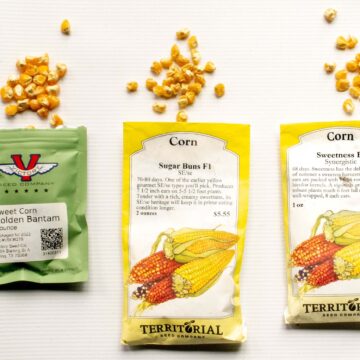
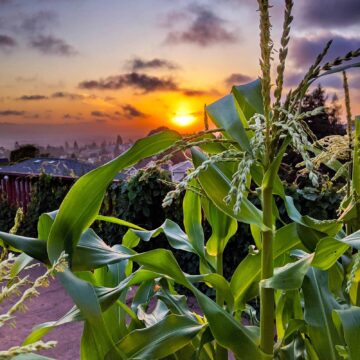









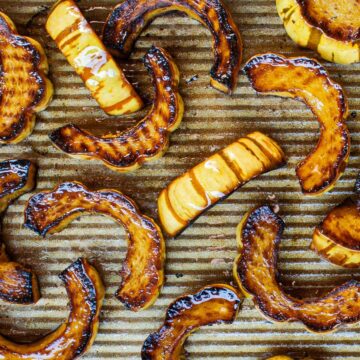
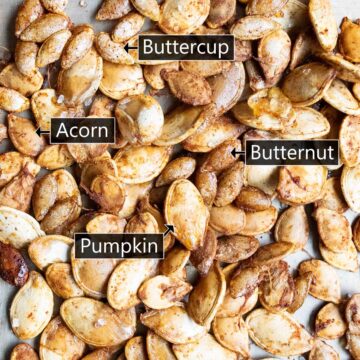


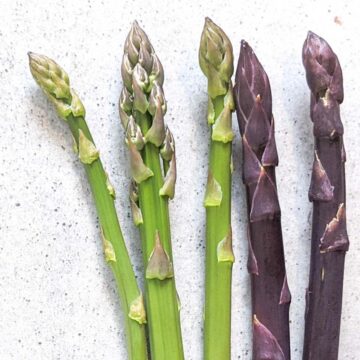
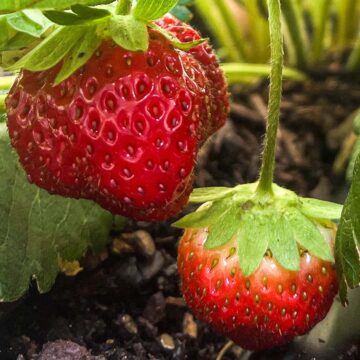
mom says
Hi, great email this morning. Strawberries - garden was about 20 by 25 feet of just the strawberries. Somedays we would pick twice a day. Would get up to 5 ice cream pails a day (5 quart per pail?). They started producing right around the middle of June. After about 3 weeks, we would mow them down. Lots and lots of runners. dark green leaves. We had good soil and lots of good fresh manure.
Veronica T says
I can't believe you'd get 5 ice cream pails a day! That's incredible.